Abstract
For about 15 years, Italian universities have been experiencing a shortage in the choice of degree programs concerning Earth Sciences, in accordance with the national trend of disaffection to STEM disciplines, both for educational reasons and because of problems in the labor market. To counter this phenomenon, in 2016, the Ministry launched the National Geology Plan (NGP) through which universities interacted directly with educational institutions in their territory. Although the numbers were small, the increase in enrollment was encouraging until the 2018/2019 academic year, before the COVID-19 pandemic. The local project “GEOLAB-UNISANNIO” of the University of Sannio in Benevento is trying to implement an educational program related to STEM fields. The authors believe that either all undergraduates or the public in general would benefit from improved Geoscience education. Accordingly, the authors, as the scientific leaders of an educational program (“Career in Geology”) under the GEOLAB–UNISANNIO project, foresee the positive effects on students’ basic scientific knowledge and academic careers of this type of approach in students’ retaining. This educational program is illustrated in its articulations with the results obtained (field experiences, production of scientific reports and posters, documentaries, general satisfaction).
1. Introduction
For several years, scientific disciplines (STEM) have been considered unappealing by high school students in Italy. This results in a low number of university enrolments in these disciplines. At the same time, there is a difficult approach for the students when facing university teaching due to a vast cultural disillusionment [1]. This feeling of disappointment results from the discovery that these disciplines are not as simple as they believed them to be. For this reason, there has been a consistent dropout rate, probably depending on emotional factors and uneasiness. To remedy this drawback the Ministry for Education, University and Research (acronym MIUR) has launched with Ministerial Decree (DM 976/2014, art.3 paragraphs 4, and 5 and art. 4) for the three-year period 2016/2018—then postponed to 2019—the new National Scientific Degree Plan (acronym PLS) [2]. Part of the innovation introduced by the PLS contemplates, for the first time, activities concerning the geological disciplines sensu lato with a specific project on a national scale: the National Geology Plan (acronym PNG). All 29 Italian universities in which there is at least one major in geosciences have joined the PNG. The full involvement shown can be explained considering that, in addition to the availability of extraordinary funds, in the previous three years, all the universities registered a significant decline in enrollments in majors in geosciences. We think this could be partly linked to a failing approach to geoscience teaching in high schools and/or to a lack of appeal to the geologist and his profession; perhaps, for these reasons, many of the students are not motivated enough, but this has not been verified yet.
It is within this framework that the objectives of the PNG are inserted. The PNG activities do not exclude the high school orientation schemes containing basic elements of geosciences already established by law; both can contribute to improving the quality of the approach.
In Benevento (Campania Region, southern Italy) the local University—Università degli Studi del Sannio—participated in the PNG with its own educational project entitled: “GEOLAB–UNISANNIO. Actions for the promotion of geological formation in the Samnite and Irpinian high schools”, involving a discrete number of schools (11) both in its own provincial territory and in the contiguous province of Avellino. The PNG/GEOLAB–UNISANNIO consists of four fundamental actions and different aims according to the types of schools. The project took place over the four-year period 2016–2019 and involved about a thousand students at high school (lyceum) and professional institutes with respective teachers (about seventy), technicians and auxiliary staff. For the university part, about fifteen teachers and researchers of geology from the Department of Science and Technology, PhD students and first-year students (about thirty) of the degree course in Geological Sciences were involved in the various project actions.
In planning the synergistic relationships between universities and high schools, the methodological foundations of the new PLS proved to be particularly effective. They were fully implemented by the PNG and applied with different methods and purposes to various local schools. Practically, a series of training courses in the classroom/lab and on the field were planned for the students, whereas continuous training activities were aimed at the teachers. The activities carried out involved all PNG actors and were subjected to a final evaluation/self-evaluation process. In applying the PNG/GEOLAB–UNISANNIO project, the main approach was that of the didactic laboratory, with theoretical and practical activities carried out mainly by students and planned in synergy with teachers under the supervision of some university experts.
With this report the Authors (F. Russo, Professor of Physical Geography and Geomorphology at the University of Sannio, and M. Sisto, Professor of Applied Sciences at the Aeclanum Institute of Higher Education in Mirabella Eclano (AV), were scientific managers, respectively for the University and for the school, of the PNG/GEOLAB–UNISANNIO.) intend to illustrate, as an example, for the public opinion of the insiders operating in the educational world, one of the most successful training courses carried out within the PNG/GEOLAB–UNISANNIO. This is a synergistic relationship established through an agreement subscribed in 2015 between the local university, Università del Sannio (acronym UNISANNIO), and the Aeclanum Institute of Higher Education in Mirabella Eclano (Campania Region, Avellino Province) (acronym ISAe) for university orientation and counseling purposes as part of a school work alternance project called: “Career in Geology: alternance training in scientific paths to orient in the world of work” (in Italian, “Professione geologo: formarsi in percorsi scientifici di alternanza per orientarsi nel mondo del lavoro”). The activities of this school work educational project were included in those of the PNG/GEOLAB–UNISANNIO, and with this name, they continued until 2019.
The geographical area affected by the training experiences of the PNG/GEOLAB–UNISANNIO was the territory of the Campanian Apennines which, with its mountainous and hilly structure, occupies the vast and rugged internal sector of southern Italy. From a geological point of view, the Campanian Apennines represent the northern portion of the largest orogenic arc that coincides with the southern Apennines [3]. It presents itself with spectacular landscapes that are the result of the many geological and geomorphological processes that have occurred over the last seven million years (from the beginning of the Miocene) and are still active with clear manifestations (active faults, volcanism, seismicity, hydrogeological hazard, erosion, etc.). These features, in addition to characterizing the area of natural hazards and risks, provide a context for the exploration of Geoscience topics and environmental issues of great educational value, while also emphasizing the role played by the geologist in land knowledge, land use planning, and hazard mitigation.
2. Materials and Methods
The new PLS was designed to provide, at the national level, adequate scientific support for the access of high school students to STEM university courses, pursuing two specific purposes: the first exclusively concerns the world of schools (students and teachers) and consists of orientation and training support activities (so-called “a” and “c” Actions) accompanied by constant verification in terms of the evaluation/self-evaluation of the progress and results obtained (so-called Action “b”); the second is mainly aimed at the university world to counter the dropout phenomenon and to strengthen the conscious choice of the STEM degree course; it mainly consists of orientation activities (so-called Action “d”) carried out in synergy with university teachers of different subjects (mathematics, physics and chemistry). The PNG acknowledged the aims of the PLS, bringing them both to universities (degree courses in Geological Sciences) and, above all, to schools.
The PLS–PNG/GEOLAB–UNISANNIO followed this line, bringing the geological knowledge of the Campania Region in terms of natural risks and georesources to 11 schools in the provinces of Benevento and Avellino (Figure 1).
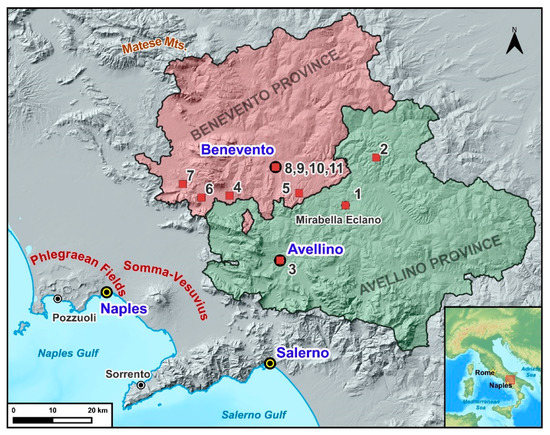
Figure 1.
Location and denomination of the schools of the provinces of Benevento (BN) and Avellino (AV) which collaborated with UNISANNIO for the realization of the PNG. (1) Higher Institute “Aeclanum” (Mirabella Eclano, AV); (2) Institute of Higher Secondary Education “Ruggero II” (Ariano Irpino, AV); (3) State Scientific High School “P.S. Mancini “(Avellino); (4) “Enrico Fermi” Higher Education Institute (Montesarchio, BN); (5) “Virgilio” Higher Education Institute (S. Giorgio del Sannio, BN); (6) Higher Education Institute “A. Lombardi “(Airola, BN); (7) Higher Education Institute “S. Alfonso Maria dè Liguori “(Sant’Agata dei Goti, BN); (8) State scientific high school “G. Rummo”(Benevento); (9) Institute of Higher Education “G. Alberti ”(Benevento); (10) Liceo and Magistrale Institute “G. Guacci “(Benevento); (11) Institute of Higher Education “Galilei-Vetrone” (Benevento).
Over a thousand students of the final classes (IV and V year, out of five years of courses), selected for their interest in STEM disciplines, and about fifty non-geologist teachers at the schools involved in the educational project took part in the laboratory activities and training courses organized by the geological community of the Department of Science and Technology of the University of Sannio.
These activities, performed in school and extra-school hours, consisting of didactic laboratories carried out in the classroom and on the field, have involved university professors, researchers and sometimes freelancers, together with teachers and students at the high schools. Lectures, lab experiments, excursions on the field, guided visits to scientific institutions, museums, etc. are some of the geological practices experienced. Materials, tools and equipment present in the university didactic laboratories were made available for laboratory experiences together with the collections of rocks, fossils, minerals and cartography. Experiments were conducted with field equipment supplied to the department and owned by freelancers. However, most of all, experience matured in the field developed by university geologists was useful. Didactic material, guides, scientific and informative articles and various gadgets were provided to students and teachers throughout the training course. All demonstrative laboratory activities concluded with scientific reports. At the school level, cognitive and satisfaction/evaluation/self-evaluation tests were administered to students and teachers of the results or progress achieved in the overall activities carried out.
3. The PNG Relationship between Unisannio and ISAe di Mirabella Eclano (AV)
Because of the success of the PLS–PNG initiatives conducted by the University of Sannio in some schools in the provinces of Avellino and Benevento and of the ease of application of the design methods, the activities developed within the project are shown below, thanks to the example of the training project called “GEOLAB–UNISANNIO.Actions for the promotion of geological formation in the Samnite and Irpinia secondary schools” in collaboration with the Higher Education Institute “Aeclanum” (ISAe) of Mirabella Eclano (AV). The relations between the two institutions began in 2015 with an educational project of school work alternation (paragraphs 33–43 of law 107/2015 called “The Good School”) called: “Career in Geology: alternance training in scientific paths orienting in the world of work”. In 2016, this alternation project was replaced by the PNG/GEOLAB–UNISANNIO for the same purposes and extended to 2018/2019: about 150 students of the Lyceum of Applied Sciences with their respective (ten) non-geologist teachers took part in it. The guidelines of the new training project were inspired by those of the new PLS, the methodological approach of which was essentially based on two lines of action: didactic lab and teacher training activities. Both lines were subjected to final evaluation/self-evaluation processes. The teachers and students were involved alike in the same demonstration activities organized in the following four independent training modules:
- I.
- Training in school and at university;
- II.
- The activities in the laboratory;
- III.
- Educational geology field trips;
- IV.
- Visits to research institutes and private companies.
With the intention to offer a broad vision on geosciences, the planned course was oriented to the following topics either of local or general interest:
- Earthquakes and seismic risk;
- Volcanic eruptions: risks and resources;
- The geotourism and georesources of Campania;
- Climate changes and environmental crisis in the future of our planet;
- Soil and landscapes: studies and strategies for their conservation;
- Medical and forensic geology as new frontiers of geosciences;
- Local material and mineral georesources;
- Fluvial floodings and landslides in Campania: a problem of risk mitigation;
- Hydrogeology of the Campanian carbonate massifs.
3.1. Training in School and at the University
The first part of the PNG/GEOLAB–UNISANNIO program was delivered by the teaching and research staff of the university to students and teachers at the school both in university environments (multimedia classrooms, educational laboratories, etc.) and in schools. The selected scientific themes were developed through traditional lectures supported by PPT images and accompanied by interactive teaching (Figure 2).
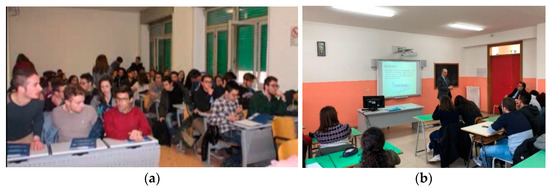
Figure 2.
Students and teachers of ISAe in the university classrooms (a) and in those of the school (b) participate, within the framework of the didactic laboratory activities (Action “a” of the PNG), in lessons on the selected geosciences topics and in the exercises of map reading (year 2017).
These activities were carried out with the aim of increasing the scientific knowledge of the interlocutors and the awareness of the productive potential of geosciences.
3.2. Laboratory Activities
Still in the context of Actions “a” and “c”, the fruitful practical activity of scientific observation was carried out using analysis tools and equipment for measurement (Figure 3) and data processing located in the university laboratory facilities. This activity (indoor and outdoor) was directed by university researchers to demonstrate the methods of conducting scientific research in the field of geosciences and the suitability of data and their scientific interpretations. From these training experiences, students and teachers have drawn the necessary information for all the phases of the GEOLAB–UNISANNIO project and, more generally, the kind of awareness that animated the PLS. The university laboratories involved in this type of activity are:

Figure 3.
Some examples of outdoor testing: (a) students engaged in laying cables and tools for seismic prospecting (year 2016); (b) pieces of cores in the cataloging boxes from which students derived the stratigraphic and lithologic information from coring subsoil (year 2016).
- i.
- Laboratory of Mineralogy and Petrography
The activities carried out in this laboratory at a demonstrative level mainly concern the mineral–petrographic characterization of geomaterials of industrial, commercial, historical–architectural, archaeological and biomineral interest. For these characterizations, in addition to the use of an optical microscope, techniques and spectroscopic equipment were shown.
- ii.
- Applied Geology Laboratory
The activities carried out in this laboratory at a demonstrative level mainly concern the geomechanical characterization of rocks and the properties of soils.
- iii.
- Laboratory of Seismology
The activities carried out in this laboratory at a demonstrative level mainly concern the monitoring of seismic events for the purpose of defining the local seismic response.
- iv.
- Laboratory of Cartography and Geographic Information Systems (GIS)
In this laboratory were illustrated materials and techniques concerning the use of thematic cartography for land planning.
The outdoor activities were designed for the direct and participatory involvement of the students (Figure 3).
During the operations, professional figures from collaborating companies demonstrated the main steps of fieldwork and, in total safety, also had young people participate in different in situ tests consisting of:
- -
- Seismic geophysical prospections;
- -
- In situ testing on the geotechnical properties of the terrain;
- -
- Continuous mechanical coring to investigate the subsurface stratigraphy for construction purposes.
3.3. Educational Outings and Field Trips
In geology, physics and chemistry, a theoretical approach must be always followed by some practice in which insight has to be accompanied by evidence; this consideration justifies the presence of so many extracurricular activities which were enacted in some well-known locations in the Campania region. Others, however, were in different geological settings, such as the volcanic landscapes of Vesuvius and Campi Flegrei near Naples. The georesources of the area were particularly highlighted, and many geosites visited offer spectacular phenomenologies and represent significant events in the history of the Apennines. Among the first destinations visited by students are the karst springs of Grassano (Benevento Province) and Serino (Avellino Province) (Figure 4) [4]. They were captured in Roman times by the so-called Augustan aqueduct (1st cent. A.D.), which supplied Naples, and by the so-called Samnitic aqueduct (1st cent. A.D.), which supplied Benevento. Even today these springs supply the metropolitan area of Naples with a recent aqueduct [4], which replaced a late 19th-century one (Figure 4b).

Figure 4.
Knowledge of the hydrogeological behavior of karst springs: (a) visit to the karst area of the Grassano springs (San Salvatore Telesino, Benevento Province) (year 2017); (b) the upwelling groundwater flow in the Serino area (Serino, Avellino Province) (year 2017).
The volcanological/geomorphological visit to the Neapolitan volcanic district and especially to Somma–Vesuvius and Campi Flegrei, whose latest eruptions took place in 1944 [5] and 1538 [6], respectively, aroused scientific interest, involving an area that today is among the most densely inhabited in the world. These globally important places could not be excluded from the PLS–GPN path. The relationships between volcanic eruptions and the development of urbanization with consequences in terms of volcanic risk were analyzed on the ground with visits to the archaeological excavations of the Roman cities of Pompeii and Herculaneum, both destroyed by the Vesuvian eruption of 79 A.D. (Figure 5).
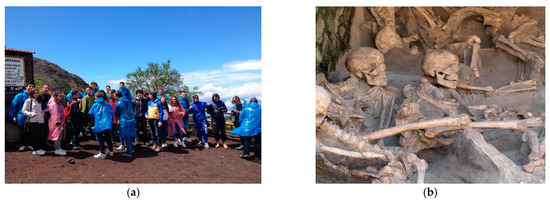
Figure 5.
Two moments during the visit to the landscapes of the Neapolitan volcanic district (year 2018): (a) a moment of pause in the ascent to the crater of Vesuvius; (b) human skeletons of victims of the 79 A.D. volcanic eruption discovered in the Herculaneum excavations.
The Phlegraean Fields are the largest and most dangerous volcanic caldera of Europe [7], whose articulated landscape was the starting point for an in-depth study on volcanic morphogenesis. The relationships between volcanism and archeology were analyzed. Along the bay of Pozzuoli, the ruins of the so-called Temple of Jupiter Serapis (3rd cent. A.D. food market) testify [8] to the existence of a volcanic phenomenology unique in the world: the “bradyseism”. It is a slow uplift and descending movement of the ground surface due to the expansion of volcanic gases sometimes preluding a volcanic eruption (Figure 6).
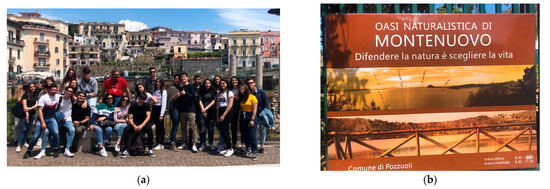
Figure 6.
Two moments of the field trip in the Phlegraean Fields (year 2019): (a) visit at the ruins of the Temple of Serapis, in the town of Pozzuoli, Napoli Province; (b) visit at the naturalistic oasis of Monte Nuovo (a tuff cone born from the last Phlegraean eruption in 1538).
In order to contact the local georesources, some field trips were attended with the aim of visiting the sites of the extraction, processing and marketing of local ornamental stones whose use in well-known monuments and buildings has crossed the borders of the province of Avellino with even foreign presences [9]. Of these lithological products, undoubtedly, the so-called “Breccia irpina” is the most famous: a cemented matrix and clast-supported conglomerate Lower Cretaceous–Oligocene aged. Today, environmental protection and landscape greatly limit the extraction of this precious and famous ornamental stone. A variety of the “Breccia irpina” is known as “Fontanarosa Stone” (Figure 7), outcropping only in two extraction sites [9] located near the small town of Fontanarosa (Avellino Province). During the visit to a renowned local company, the students and teachers carried out a small internship on the processing of stone material and the production of artistic artefacts.
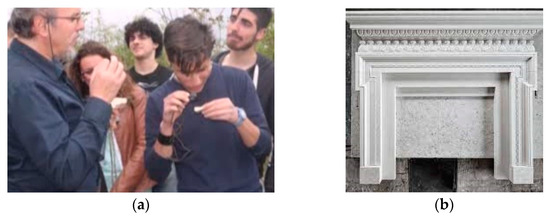
Figure 7.
Two moments of the visit to a lapideous valuable georesources (year 2018): (a) palaeontological observations in a ‘Breccia irpina’ quarry in Fontanarosa (Avellino Province); (b) transformation of the quarried stone material into precious artistic artefacts.
The field trip also had as its object the visit of well-known local geosites considered as places of geological interest in the context of possible itineraries for sustainable geotourism [10,11]. Very spectacular, even for a non-specialist audience, are the methane-emitting mud volcanoes locally called “Bolle della Malvizza” in the territory of Montecalvo Irpino (Avellino Province) and the gypsum open-air mines of the Monte Castello in the territory of Savignano Irpino (Avellino Province). In the first location, the geosite consists of numerous small cones suddenly opening in the rural landscape continuously emitting methane gas, water and mud in the form of bubbles sometimes flowing down the sides of the cone (Figure 8). In the second location, the gypsum mines of Monte Castello and sulfur springs were visited. Surely, the site was already known in the Neolithic era, considering the archaeological remains found, but the beginning of mining dates back to no later than the nineteenth century. The gypsum (Figure 9) is part of the Apennine evaporite formation: the evaporite of Monte Castello dates back about 5.5 My and is connected to the history of the Mediterranean Sea’s desiccation (salinity crisis). The places visited aroused great interest among the ISAe students and teachers, especially in terms of the conservation and promotion of the local heritage georesources.
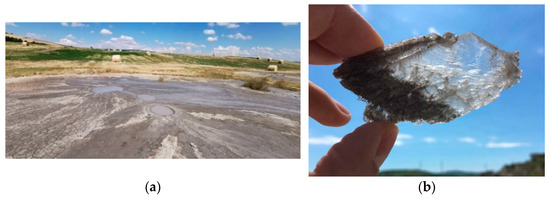
Figure 8.
Methane emissions and gypsum deposits: (a) mud volcanoes at the Bolle della Malvizza in Montecalvo Irpino (AV); (b) the gypsum of Savignano Irpino quarries (AV).

Figure 9.
Two moments of ISAe students’ visits to scientific research institutes: (a) the fascinating tale of the birth of the Earth and the appearance of life proposed in a multimedia way by a BioGeo Museum researcher (year 2019); (b) a researcher illustrates the research conducted by the INGV during the visit to the research center in Grottaminarda (AV) (year 2018).
3.4. Visit to the Institutional Research Centers and Other Initiatives
In order to stimulate interest in the scientific work of researchers in the ISAe students and their teachers, study visits have been organized to prestigious research institutes, where important research projects are being carried out in the biogeoscience sector. A visit to the headquarters of BIOGEM (Institute of Molecular Biology and Genetics) was particularly relevant. In this institute, the ISAe students participated in simple laboratory experiments and visited the local BioGeo Museum, where fossil specimens and multimedia structures illustrate the phases of the evolution of life on Earth. The latter was illustrated with multimedia techniques in Quadrisphere and Cinema 7D, directly involving the viewer through games of monitors and mirrors, augmented reality viewers, mobile seats and fumes diffused in the environment (Figure 9a).
Lectures on Apennine seismicity, the seismic monitoring room and the use of some demonstration tools were the highlights of the visits conducted to the Centre for Seismology and Seismic Engineering of the INGV (National Institute of Geophysics and Volcanology) in Grottaminarda (Avellino Province) (Figure 9b). This prestigious research center, within the National Seismic Network with satellite transmission, is a highly trained scientific and technological center located in a highly seismic area.
Still, within the PLS/PNG plan, the ISAe students and teachers also visited other important scientific institutions, listed below, where they were able to appreciate the work of scientists and their excellence in the field of scientific dissemination.
- -
- The Museums of Mineralogy and Palaeontology of Naples (Figure 10): the first, founded in 1801, preserves a collection of over 30,000 artifacts and minerals collected since the end of the 18th century (Vesuvian and artificial crystal collections, meteorites and ancient scientific instruments); the latter, founded in 1932, displays several collections of mammal, plant and reptile fossils and reconstructions in dioramas of the lives of prehistoric humans.
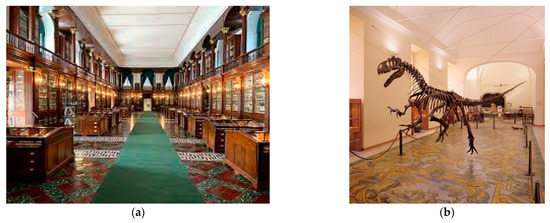 Figure 10. Images of the visit to some scientific institutions in Naples in 2018. (a) Museum of Mineralogy; (b) the “Dinosaur Room” of the Museum of Palaeontology (the reptile fossil, dating back 135 million years, comes from the USA).
Figure 10. Images of the visit to some scientific institutions in Naples in 2018. (a) Museum of Mineralogy; (b) the “Dinosaur Room” of the Museum of Palaeontology (the reptile fossil, dating back 135 million years, comes from the USA).
- -
- The Science Centre of “Città della Scienza” in Naples (http://www.cittadellascienza.it, accessed on 11 January 2023): the first Italian interactive science museum;
- -
- GEOBIOLab, in Benevento, an educational museum dedicated to the history of the Earth and the evolution of biodiversity, which combines scientific research and recreational activities;
- -
- ISA-CNR (Institute of Food Sciences, National Research Council), in Avellino (www.isa.cnr.it, (accessed on 11 January 2023)). The research activities of CNR-ISA are focused on the study of food quality and safety, as well as the relationship between food composition and health.
4. Results
The PLS–PNG training experienced by the University of Sannio in collaboration with some schools in the provinces of Benevento and Avellino was designed to achieve specific educational purposes in the sectors of STEM disciplines with particular attention (as regards the PNG) to geosciences. The authors are convinced that the activities carried out on the 11 school subjects have been useful for locally improving the educational system in approaching the study of scientific disciplines in terms of objective fulfillment. However, above all, they are convinced that the synergy between universities, research institutions and schools is the best means for stimulating the interest of young people in geosciences. This point of view is supported by the various satisfaction tests, the verification of progress and the results achieved and evaluation/self-evaluation that has been administered to the students and teachers of the school participating in the PLS/PNG–GEOLAB Unisannio to complete the project activities (so-called Action “b” foreseen by the PLS). The results of this “Action” tell us that most of the interlocutors expressed a positive reaction to all the activities proposed because of the informal, didactic atmosphere and because the lessons took place in different situations and places. Of the interlocutors mentioned above, some have shown a significant and motivated interest in geosciences. Furthermore, among these interlocutors, only a few (less than 10%) declared their total lack of interest in geosciences or in STEM disciplines as a whole. The data on the PLS/PNG educational path, therefore, seem to be completely comforting and in line with those already known in the specific scientific literature [12].
Specifically, it can be said that from 2016 to 2019, the activities PLS–PNG carried out in synergy between the University of Sannio and ISAe of Mirabella Eclano have produced the following remarkable results:
- -
- The reinforcement of basic and STEM science teaching, both in quality and in the development of new scientific items;
- -
- The training of teachers, who were asked to emphasize the role of geosciences alongside other science disciplines;
- -
- Reducing school dropout rates.
Anyway, every single action of the PLS project has always maintained the following basic principle: Italian higher education has great potential to contribute to the country’s cultural, social and economic development, and the role of geosciences is not secondary at all. Indeed, geosciences can play a crucial role in the development of holistic systems thinking, requiring spatial thinking skills and a new, original, conception of time. In addition, geoscience fieldwork involves special strategies and methodologies that should be acquired to acquire a new sensibility to contemporary problems [13]. Similar concepts and initiatives have also been developed in the USA for years [14,15].
Some examples may show the effective involvement of the students in the whole training project. In fact, Figure 11, for instance, shows an excerpt of a thematic map created by one of the students as the final result of the geological excursions in the field conducted during the laboratory activities under the supervision of the teacher.
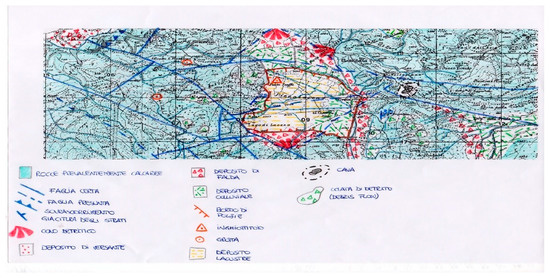
Figure 11.
An example of a hand-drawn thematic map with appropriate symbology created by one of PLS–PNG student under the guidance of expert teachers as a result of the knowledge acquired in the field during the laboratory activities.
The results of PLS–PNG activities obtained from the university/school collaboration were presented at the Joint Geological Congress SIMP (Italian Society of Mineralogy and Petrology)—SGI (Italian Geological Society)—SOGEI (Italian Geochemical Society)—AIV (Italian Volcanology Association). In Poster Session S31: Geosciences at a school in 2017, held in Pisa, Italy, 3–6 September 2017, entitled “Geosciences: a tool in a changing world”, three high schools participating in the project presented their papers, which were published as abstracts in the relevant proceedings (Figure 12a) [16,17,18].

Figure 12.
(a) The cover of the abstract book of the International Congress entitled Geosciences: a tool in a changing world, held in Pisa in 2017; (b) the cover of the abstract book of the Fourteenth National Meeting of GIT (Geosciences and Information Technologies), a section of the Italian Geological Society, held in Melfi (PZ) in 2019.
In the same Congress, in Session S24: “Emerging pollutants in the environment: a challenge for geochemistry and isotopic geochemistry,” the preliminary results of geochemical research carried out by ISAe students were presented. It concerned air quality, and it was published as an oral communication and as an abstract in the same proceedings [19]. This research was carried out with daily recordings—lasting six months—of the values of six environmental parameters (sulfur dioxide, nitrogen dioxide, ozone, carbon monoxide and fine particles such as PM10 and PM2.5). The subsequent statistical analysis carried out by the students resulted in an air quality ranking for 15 local municipalities near the ISAe high school, making young people learn the specifics of a scientific survey, patient data collection, report writing and the public presentation of the results.
In 2019 the ISAe students/teachers, again within the PNG/GEOLAB–UNISANNIO, in collaboration with the researchers of the INGV (Irpinia office), created a short documentary film dedicated to the Irpinia–Basilicata 1980 earthquake and the memory that remained in institutions and citizens. This is another positive experience of scientific research carried out by students using modern tools such as ICT (information communication technologies). The documentary was presented by the students in the section “Science Meets the Citizen of the Future. Students between Technology and Risk Awareness” at the Fourteenth National Meeting of GIT (geosciences and information technologies) (Figure 12b) held in Melfi (Potenza) in 2019.
From what has been stated so far, it is also to be considered an important result that a general improvement in the performance and interest of students in STEM disciplines was perceived both at the managerial level and by the schoolteachers during the period of administration of the PNG/GEOLAB format, a consideration that agrees with what was stated by Levine et al. (2007), according to which [15], the attendance of STEM courses in high schools is an important predictor, especially when these courses are conducted by universities or scientific research institutes. For Carrick et al. (2016) [12], in fact, it is important that young people have outdoor experiences in geosciences, participate in introductory courses [20], have met high school teachers trained and motivated towards geosciences and have the support of parents [12]. In our case, this is configured as another advantage of the PLS–PNG courses conducted by UNISANNIO in the schools of the Irpinia and Benevento areas.
Finally, a concluding ceremony locally sanctioned the end of the PNG training course for each school. The event was attended by students, teachers, school managers, parents, local authorities and representatives of the cultural institutions and companies involved. The event, once again, saw the students as protagonists who illustrated the salient moments of the annual PLS–PNG course with public presentations (photos and videos). Everyone received the right appreciation and a certificate of participation (Figure 13).
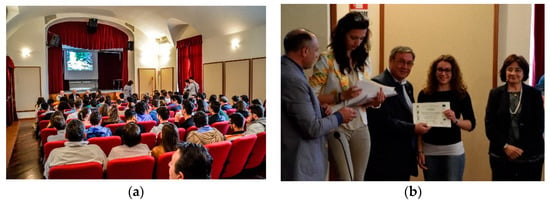
Figure 13.
Two moments of the awarding of students at the end of the 2016 course (ISAe high school headmaster Pr. Mrs. F. De Vizia, Pr. F. Russo and Pr. M. Sisto): (a) the hall of the Mirabella Eclano Theater, during the presentation of certificates to the students participating in the PLS; (b) a moment of the award ceremony.
5. Final Remarks
As stated above, the results of the satisfaction questionnaires administered at the end of each annual program have always shown excellent results in terms of the quality of the experiences lived. From this derives a first and general conclusion: the full satisfaction of the application of PLS–PNG training projects for both university and school components. However, some critical issues emerged during the period of application of PLS–PNG projects that have often conditioned the full achievement of the training objectives. First, the very duration of the application of the training project, a three-year period that later became four years, proved to be incompatible with the numerous other scholastic and extracurricular activities that characterize the training of students in Italian educational institutions. In fact, the obligation to apply alternance programs and the need to increase the appeal and seek funds in the regime of school autonomy has led the directors of the schools to join or to take charge of other project initiatives (national, regional, etc.). In this way, situations of conflict, if not confusion, have been created in the same student audience, but above all, attention has been diverted from long-term projects such as PLS–PNG. On the whole, the project activities put in place by the schools being mostly characterized by extracurricular activities, that is, to be conducted outside school hours in order not to affect the primary training activities of the school, have generated a clear difficulty in managing teaching and working times and loads for the engaged student audience and the teachers involved. This has led to a progressive thinning over time of the student audience and the teachers participating in PLS–PNG with evident difficulty in maintaining the continuity of actions and the achievement of the training objectives of the educational project. The legitimate turnover of teachers and school leaders involved in the PLS–PNG project should not be overlooked, which has negatively affected the continuity of teacher training and, in general, the interest in the project itself.
The PLS–PNG educational project itself over the four-year period of application has changed in its objectives and purposes to the point of being considered, at the moment, completely marginal and therefore not applied, a problem linked, above all, to the repeated changes in political interest and strategies that in a few years have affected ministerial policies for education in the country.
At the level of university commitment, this has represented a clear handicap both in terms of reductions in and different distributions of available funds and a continuous review of the complex actions put in place and the related objectives to be achieved.
Despite these vicissitudes and critical issues that have undoubtedly undermined the importance and scope of the educational project, PLS–PNG has been successfully carried out and recognized throughout the country, thanks, above all, to the massive commitment, not disinterest, profuse in Italian universities. Following this path, the PLS–PNG/GEOLAB–UNISANNIO project was conducted in 11 schools in the province of Avellino and Benevento, of which, only four experimented with the complete application. In other schools, on the other hand, the system criticalities narrated above did not allow full applications. In some, the project started late, limiting the results achieved; in others, the project ended early due to the onset of conflicts that arose with other training strategies adopted by schools.
The PLS–PNG/GEOLAB–UNISANNIO conducted in collaboration with the ISAe school in Mirabella Eclano is the most successful example of the application of the PLS–PNG project. The results obtained are very important, despite the critical issues that have emerged, and encourage the continuation of the design work: an important indication that comes, as a positive fact, also from the other schools that have collaborated with UNISANNIO within PLS–PNG. From the statistics compiled by the schools participating in PLS–PNG (also at the national level), it has emerged that at the end of high school, a higher number of students (from 10% to 20%) have decided to continue their training by consciously enrolling in a university course of study considered congenial to their abilities; the awareness of the choice, gained in the PLS path, is evidenced by the fact that they have all taken and passed the admission tests to the Italian university faculties and that today they are about to graduate.
Since 2019, the PLSthe -PNG project has stopped being applied and has been supplanted in ministerial policies by other training projects. However, the former PLS–PNG working groups continued to maintain relations with educational institutions and, despite the COVID-19 pandemic period, monitored the careers of ex-PLS–PNG students leaving high school. As far as the PNG/GEOLAB–UNISANNIO project is concerned, the few statistical data available to date confirm a slight general increase (5%) in the choice by former PLS–PNG students to continue their school career with the choice of a university course in STEM disciplines. The same percentage is recorded for students who have chosen degree courses in geosciences.
A significant sample of students from the four high schools that completed the PLS–PNG project was contacted when enrolling in college courses.
In general, it has been seen that the different ages of students, the longer duration of some degree programs (e.g., medicine and surgery) and the individual histories of each have influenced the choice of university pathways; the majority of students chose the many engineering majors, and many opted for biotechnology, biology and medicine (the latter has particularly selective entrance tests). Smaller numbers concern the choice of courses of study in geosciences, architecture, chemistry, physics and only a few economics and legal disciplines. The remaining students opted for university choices in the psycho-pedagogical, linguistic and humanistic sectors, remained undecided or chose not to continue their studies (Figure 14).
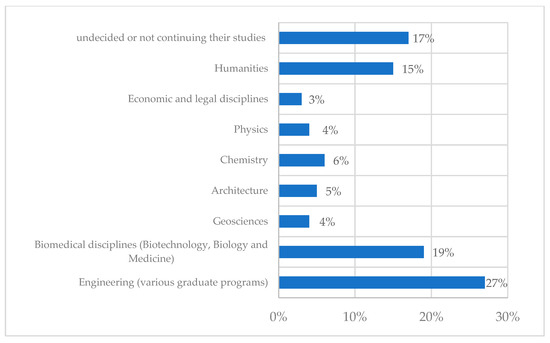
Figure 14.
The choices after high school graduation of a sample of students who participated in the PLS–PNG project.
These analytical data concerning the conscious university choice, even if carried out in small numbers, still allow to confirm a picture of the Italian situation that still appears quite plastered and strongly influenced by the labor market and undermined by cultural stereotypes. In fact, from Alma Laurea 2021 data [21] it has emerged that the medical-health and engineering professions are still the best known and most popular in public opinion. These are followed by the legal and humanistic professions, mostly identified with the world of schools and public administration. The value of STEM disciplines, although slightly increasing, is still low and marginal in public opinion, which sees it relegated to professionalism linked only to the world of school and scientific research, and it is therefore necessary to reverse this trend [22,23].
In this context, therefore, geosciences, supported by training projects such as PLS–PNG, can play an important role as an added value as an alternative to other established professions. The experience gained with the PLS–PNG/GEOLAB–UNISANNIO confirms that the students and teachers concerned have improved their knowledge of geosciences and understood their importance in terms of socio-economic and cultural development. In the same years, other similar educational projects with the same aims as PLS–PNG were successfully promoted and implemented at the national level. Among these, we mention the “O3E Project: raising awareness of natural risks at school by observing the environment through seismic, meteorological and hydroelectric measurements”, which took place between 2008 and 2010 (funded by the European Union) and the “International Earth Sciences Olympiad” (IESO), organized annually by the IGEO (International Geoscience Education Organization). At the local level, the propagandistic contribution promoted annually by the regional orders of geologists in concert with the regional school offices of public education is important. In Campania, until 2019, the Order of Geologists promoted information days entitled “The Earth seen by a professional. At school with the geologist”. However, it has been experienced that the application of these projects in educational institutions is not at all simple and immediate as it requires an accurate analysis of the endogenous (internal) and exogenous (external) variables of the system composed of the educational project and the actors who must carry it out. The first concerns the identification of strengths and weaknesses or criticalities of the system. The second concerns the opportunities offered by the system and the threats that loom over it.
In our case, the SWOT analysis, carried out a posteriori, gave the following results (Figure 15):
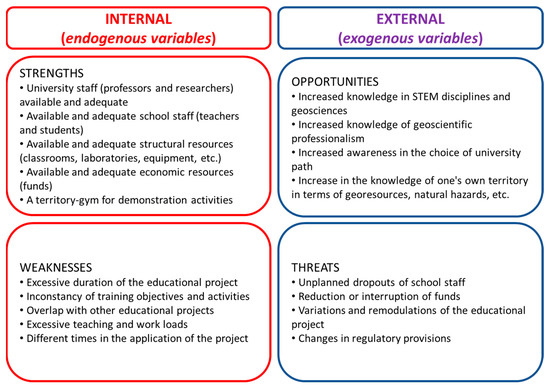
Figure 15.
The SWOT analysis of PLS–PNG/GEOLAB–UNISANNIO.
6. Conclusions
Due to the pandemic events, the PLS–PNG experience has been temporarily suspended but will certainly be resumed when conditions permit.
Meanwhile, the first students who took PLS–PNG courses have now reached graduation in several STEM fields: geology, environmental engineering, civil engineering, architecture and naturalistic or biomedical fields (biology, biotechnology, chemistry, medicine, etc.). Some are already employed in the private sector or public administrations; some others are starting doctoral programs because they wish to remain in academia.
The PLS–PNG pathway is definitely a valuable training experience that should be continued and funded in a nation such as Italy where there are 16.4 young graduates in STEM subjects per 1000 people aged 20–29 (EU average: 21 per 1000). The percentage of young female STEM graduates still falls short (14.9 per 1000), with a distinct gender gap. Furthermore, Italian students who are good at reading and who also perform well in math and science reach just 26.7% (in Germany, this number is 45.4%) [24]. Unfortunately, even in our multi-year project, there remains a prevalence of male over female students.
Authors like to think that, in addition to having conveyed notions, methods and peculiar forma mentis to these disciplines, they have shown young people the passion that strengthens the complex but fascinating world of science-based professions.
Author Contributions
Conceptualization, methodology, resources, writing—original draft preparation, F.R. and M.S. All authors have read and agreed to the published version of the manuscript.
Funding
This research received no external funding.
Data Availability Statement
Not applicable.
Acknowledgments
The authors would like to thank the hundreds of young people who have approached the PLS–PNG courses with interest and participation in the various years, wishing all students a bright future. They are particularly grateful to the three anonymous referees who, with their valuable comments and suggestions, have contributed to making significant improvements to the primitive text. The authors also appreciated the support of A. Cusano in editing the cartographic paper and Gennaro Compagnone in revising the translated text.
Conflicts of Interest
The authors declare no conflict of interest.
References
- NSF (National Science Foundation). Geosciences Education: A Recommended Strategy. Available online: https://www.nsf.gov/geo/adgeo/geoedu/97_171.jsp (accessed on 19 May 2022).
- PLS (Piano Lauree Scientifiche, National Plan for Science Degrees). Home. Available online: https://www.pianolaureescientifiche.it/ (accessed on 18 May 2022).
- Vitale, S.; Ciarcia, S. The dismembering of the Adria platforms following the Late Cretaceous-Eocene abortive rift: A review of the tectono-stratigraphic record in the southern Apennines. Int. Geol. Rev. 2021, 64, 2866–2889. [Google Scholar] [CrossRef]
- Fiorillo, F.; Esposito, L.; Pagnozzi, M.; Ciarcia, S.; Testa, G. Karst springs of Apennines typified by upwelling flux. Acque Sotter. Ital. J. Groundw. 2018, 7, 21–30. [Google Scholar] [CrossRef]
- Rolandi, G.; Paone, A.; Di Lascio, M.; Stefani, G. The 79 AD eruption of Somma: The relationship between the date of the eruption and the southeast tephra dispersion. J. Volcanol. Geotherm. Res. 2007, 169, 87–98. [Google Scholar] [CrossRef]
- Di Vito, M.; Lirer, L.; Mastrolorenzo, G.; Rolandi, G. The 1538 Monte Nuovo eruption (Campi Flegrei, Italy). Bull. Volcanol. 1987, 49, 608–615. [Google Scholar] [CrossRef]
- De Natale, G.; Troise, C.; Mark, D.; Mormone, A.; Piochi, M.; Di Vito, M.A.; Isaia, R.; Carlino, S.; Barra, D.; Somma, R. The Campi Flegrei Deep Drilling Project (CFDDP): New insight on caldera structure, evolution and hazard implications for the Naples area (Southern Italy). Geochem. Geophys. Geosystems 2016, 17, 4836–4847. [Google Scholar] [CrossRef]
- Pappalardo, U.; Russo, F. Geomorphological and archaeological evidence of the ground movements (bradyseisms) in the Phlegraean Fields (Naples, Italy). In Geoarchaeology of the Landscapes of Classical Antiquity; Vermeulen, F., De Dapper, M., Eds.; Proc. Int. Coll. Ghent; Peeters Publishers: Leuven, Belgium, 1998; pp. 137–150. [Google Scholar]
- Ciarcia, S.; Vitale, S.; Langella, A.; Calcaterra, D.; Colella, A.; de Gennaro, M. La Pietra di Fontanarosa. In Le Pietre Storiche Della Campania: Dall’oblio Alla Riscoperta, 1st ed.; de Gennaro, D.M., Calcaterra, A.L., Eds.; Luciano Editore: Napoli, Italy, 2013; pp. 373–380. ISBN 9788860261823. [Google Scholar]
- Valente, A.; Sisto, S.; Russo FMagliulo, P. Strength and Weakness in Geotourism: The case study of Irpinia (Campania, Italy). CSE-City Saf. Energy 2018, 1, 21–34, ISSN online edition 2284-3418. [Google Scholar]
- Di Lisio, A.; Sisto, M.; Iscaro, C.; Russo, F. Geotourism and Economy in Irpinia (Campania, Italy). Rend. Online Soc. Geol. It 2016, 39, 72–75. [Google Scholar] [CrossRef]
- Carrick, T.L.; Miller, K.C.; Hagedorn, E.A.; Smith-Konter, B.R.; Velasco, A.A. Pathways to the Geosciences Summer High School Program: A Ten-Year Evaluation. J. Geosci. Educ. 2016, 64, 87–97. [Google Scholar] [CrossRef]
- Roca, N.; Garcia-Valles, M. Trainee Teacher Experience in Geoscience Education: Can We Do Better? Geoheritage 2020, 12, 92. [Google Scholar] [CrossRef]
- Adetunji, O.O.; Ba, J.-C.M.; Ghebreab, W.; Joseph, J.F.; Mayer, L.P.; Levine, R. Geosciences Awareness Program: A Program for Broadening Participation of Students in Geosciences. J. Geosci. Educ. 2012, 60, 234–240. [Google Scholar] [CrossRef]
- Levine, R.; González, R.; Cole, S.; Fuhrman, M.; Le Floch, K.C. The Geoscience Pipeline: A Conceptual Framework. J. Geosci. Educ. 2007, 55, 458–468. [Google Scholar] [CrossRef]
- Ciarcia, S.; La Luna, A.; Russo, F.; The Students of the IISS-CAT “Ruggero II” High School, Ariano Irpino (AV). An educational approach for a PLS Geological Information Laboratory. In Proc. of SIMP-SGI-SOGEI-AIV Congr. 2017; Società Geologica Italiana: Roma, Italy, 2017; p. 541. ISSN 2038-1719. [Google Scholar] [CrossRef]
- De Nunzio, A.; Langella, A.; Nicoletti, M.C.; Russo, F.; Travaglione, S.; The Students of Applied Sciences of the Galilei–Vetrone High School, Benevento. Looking for the lithosphere. In Proc. of SIMP-SGI-SOGEI-AIV Congr. 2017; Società Geologica Italiana: Roma, Italy, 2017; p. 548. ISSN 2038-1719. [Google Scholar] [CrossRef]
- Russo, F.; Sisto, M.; Valente, A.; The Students of the Aeclanum High School, Mirabella Eclano (AV). How does the geologist work? The educational approach of a PLS Laboratory. In Proc. of SIMP-SGI-SOGEI-AIV Congr. 2017; Società Geologica Italiana: Roma, Italy, 2017; p. 569. ISSN 2038-1719. [Google Scholar] [CrossRef]
- Russo, F.; Sisto, M.; Valente, A.; The Students of the Aeclanum High School, Mirabella Eclano (AV). The role of atmospheric pollutants in the assessment of Air Quality Index in the middle of Irpinia (Campania, Italy). In Proc. of SIMP-SGI-SOGEI-AIV Congr. 2017; Società Geologica Italiana: Roma, Italy, 2017; p. 440. ISSN 2038-1719. [Google Scholar] [CrossRef]
- Pelfini, M.; Bollati, I.; Pellegrini, L.; Zucali, M. Earth sciences on the field: Educational applications for the comprehension of landscape evolution. Rend. Online Soc. Geol. It. 2016, 40, 56–66. [Google Scholar] [CrossRef]
- ALMA LAUREA, Rapporto 2022 sul Profilo dei Laureati. Available online: https://www.almalaurea.it/informa/news/2022/06/15/rapporto-almalaurea-2022 (accessed on 23 July 2022).
- Sturani, M.; Parravicini, P.; Pelfini, M. Pre-service teachers’ attitudes in planning and scheduling geofield trips at secondary school level. Rend. Online Soc. Geol. It. 2018, 45, 77–82. [Google Scholar] [CrossRef]
- Pelfini, M.; Parravicini, P.; Fumagalli, P.; Graffi, A.; Grieco, G.; Merlini, M.; Porta, M.; Trombino, L.; Zucali, M. New methodologies and technologies in Earth Sciences education: Opportunities and criticisms for future teachers. Rend. Online Soc. Geol. It. 2019, 49, 4–10. [Google Scholar] [CrossRef]
- STEM, una Sfida per L’italia. Available online: https://www.openpolis.it/esercizi/il-divario-di-genere-nelle-materie-stem/ (accessed on 22 May 2022).
Disclaimer/Publisher’s Note: The statements, opinions and data contained in all publications are solely those of the individual author(s) and contributor(s) and not of MDPI and/or the editor(s). MDPI and/or the editor(s) disclaim responsibility for any injury to people or property resulting from any ideas, methods, instructions or products referred to in the content. |
© 2023 by the authors. Licensee MDPI, Basel, Switzerland. This article is an open access article distributed under the terms and conditions of the Creative Commons Attribution (CC BY) license (https://creativecommons.org/licenses/by/4.0/).